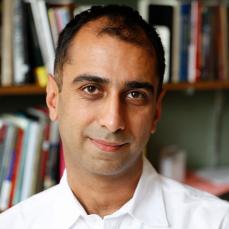
Nikhil Anand, assistant professor of anthropology
Thursday, April 13, 2017
By Abigail Meisel
We take the supply of fresh water for granted in the United States, but as our infrastructure crumbles, so, too, do the leaky water mains that carry this vital resource into our homes, schools, and businesses. In Flint, Michigan, for example, the water has become contaminated through damaged water mains.
How can we live with the environmental uncertainly that is almost surely in our future? The answer may lie with people who are currently coping with this reality: the poor of Mumbai.
The intersection of water and society lies at the heart of a new book by Nikhil Anand, assistant professor of anthropology: Hydraulic City: Water and the Infrastructures of Citizenship in Mumbai.
Anand’s complex ethnographic study crosses the disciplines of anthropology, environmentalism, and urban planning. He not only examines the realities of Mumbai’s water supply, but also deciphers the social attitudes toward water in this megapolis, the fourth most populous city in the world, with more than 20 million residents.
“When I was growing up in Mumbai, it was common sense knowledge that water is scarce in the city," says Anand. “We always heard ‘water is scarce,’ but that doesn’t make sense. The city is surrounded by water. We have annual monsoons. We learn not to see the water that is all around us, and instead just see the water that comes (or does not come) out of the tap.”
Working through what he calls “the social life of water” was one of many challenges Anand tackled in writing Hydraulic City. Another was scaling Mumbai’s vast water-supply bureaucracy, a water department with hundreds of engineers overseeing more than 3,000 miles of water mains across the city.
Unlike many ethnographic studies that focus on a single group, Hydraulic City analyzes a cross-section of society including the people marginalized in slums and those who control the water supply.
“The water department has plenty of water and plenty of money,” Anand says. “The city water department regularly posts an annual operating surplus of at least 300 million dollars. Yet, informal residents are actively ignored in the delivery of services. These residents need to expend considerable time and energy getting the water they need.”
Anand follows the trail of water into the city, and thereby exposes the inequalities of distribution, and how poor people make powerful claims in the absence of substantive rights.
“The everyday life of water infrastructure reveals the making of nature, law, politics, and economics,” he says.
Anand put public policies about water into an historical context.
At the turn of the nineteenth century, major cities around the world—London, Paris, New York, and Mumbai—decided to create a public water supply as an answer to problems with a private water distribution system. Today, there is a comparable tension between experts proposing a market-driven system versus a publically-controlled one. Internationally, debates are on the rise regarding the about the benefits and drawbacks of privatizing the distribution of natural resources.
Written for a general audience, Hydraulic City has two main messages, according to Anand. He argues that it’s important to recognize that any system, public or private, of distribution of water and other natural resources isn’t perfect.
Systems often don’t work the way they are designed, Anand explains. “Yet, marginalized residents defend public systems despite the difficulty they have with them. Why is that?”
In addition, he believes that studying the way that poor people are dealing with environmental uncertainty is a way of “inhabiting the future” as the seemingly limitless supply of water and other natural resources is increasingly threatened.
"Cities are full of nature, if you know how to look,” Anand says. “To tell the story of water is to describe how cities and citizens are made and unmade in everyday life.”